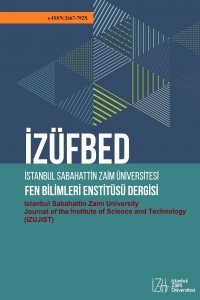Türkiye'den Bazı Endemik Bitki Türlerinin Uçucu Yağ ve Yağ Asit Kompozisyonu
Ekonomik değerli ve endemik bitkilerin birçok önemli kullanım alanları bulunmaktadır. Bu araştırmada endemik bitki taksonları olan Origanum acutidens, Micromeria elliptica, Nepeta congesta var. congesta ve Ballota saxatilis subsp. brachyodonta yaprak esansiyel yağ ve yağ asidi bileşimleri analiz edildi. Belirlenen ana bileşenler şu şekildedir: karvakrol (%18.2), timol (%11.3) ve karyofilen oksit (%7.5) Origanum acutidens 'te; kamfor (%12.9), karyofilen oksit (%12.5) ve pulegon (%10.2) Micromeria elliptica'da; 1,8-sineole (%18.8) ve nepetalakton (%14.5) Nepeta congesta var. congesta’da; -karyofillen (%11.0) ve pulegon (%7.2) Ballota saxatilis subsp. brachyodonta’da ana bileşenler olarak saptandı. Palmitik (%31.4), steraik (%13.2), petroselinik (%22.2), linoleik (% 9.9) ve linolenik asit (%22.5) ana yağ asitleri olarak belirlenmiş bulunmuştur.
Essential Oil Compounds of Some Endemic Plant Species From Turkey
Economically important and endemic plant species have many important uses. In this research essential oil and fatty acid constituents of endemic plant taxa Origanum acutidens, Micromeria elliptica, Nepeta congesta var. congesta and Ballota saxatilis subsp. brachyodonta were analyzed. Detected major compounds as: carvacrol (18.2%), thymol (11.3%) and caryophyllene oxide (7.5%) in Origanum acutidens; camphor (12.9%), caryophyllene oxide (12.5%) and pulegone (10.2%) in Micromeria elliptica; -cineole(18.8%) and nepetalactone (14.5%) in Nepeta congesta var. congesta; -caryophyllene (11.0%) and pulegone (7.2%) in of Ballota saxatilis subsp. brachyodonta. Palmitic (31.46%), Steraic (13.22%), Petroselinic (22.22%), Linoleic (9.94%) and Linolenic acid (22.53%) were found to be main fatty acids.
Keywords:
Essential oil, , Fatty acid,
___
- Celep, F., & Dirmenci, T. (2017). Systematic and Bio-geographic Overview of Lamiaceae in Turkey, Natural Volatiles and Essential Oils, 4, 14-27.
- Christie, W.W. (1990). Gas Chromatography and Lipids: A Practical Guide. The Oily Press, 307.
- Davis, P.H. (1982). Flora of Turkey and East Eagean Island: Edinburgh University Press., 7.
- Duru, ME., Öztürk, M., Ugur, A., & Ceylan, Ö. (2004). The essential oil and in vitro antimicrobial activity of Micromer cilicica from Turkey, Journal of Ethnopharmacology, 94, 43-48.
- Fraternale, D., & Ricci, D. (2014). Essential oil composition and antifungal activity of aerial parts of Ballota nigra ssp. foetida collected at flowering and fruiting times, Natural Product Communications, 9, 1015-1018.
- Gottumukkala, V.R., Mukhopadhyay, T., Annamalai, T., Radhakrishnan, N., & Sahoo, M.R. (2011). Chemical constituents and biological studies of Origanum vulgare, Pharmacognosy Research, 3, 143-145.
- Kılıç, O., & Özdemir,FA. (2016). Variability of Essential Oil Composition of Origanum vulgare subsp. gracile Populations from Turkey, Journal of Essential Oil Bearing Plants, 19,2083-2090.
- Kilic, O., Behcet, L., & Bagci, E. (2013). Essential oil compounds of three Nepeta L. Taxa From Turkey, and Their Chemotaxonomy, Asian Journal of Chemistry, 25, 8181-8183.
- Marinkovic, B., Marin, P., Knezevic, Vukcˇevic DJ., M.D. Sokovic., & Brkic, D. (2002). Activity of Essential Oils of Three Micromeria Species (Lamiaceae) Against Micromycetes and Bacteria, Phytotheraphy Research, 16, 336–339.
- Nakatsu, T., Lupo, A.T., Chinn, JW., & Kang, R.K.L. (2000). Biological activity of essential oils and their constituents, Natural Product Chemistry, 21, 571–63.
- Raybaudi-Massilia, RM., Mosqueda-Melgar, J., Soliva-Fortuny, R., & Martín-Belloso, O. (2009). Control of pathogenic and spoilage microorganisms in fresh-cut fruits and fruit juices by traditional and natural antimicrobials, Compr Food Science Food Safety, 8, 157–180.
- Rivera, N., & Obon, C. (1992). Ethnobotany of old world Labiatae, Royan Bot Gardens, 437-454.
- Semnani, KM., Saeedi, M., & Akbarzadeh, M. (2007). The essential oil composition of Ballota nigra, Chemistry of natural compounds, 43(6), 722-723.
- Tabanca, N., Kirimer, N., Demirci, B., Demirci, F., & Baser, KHC. (2001). Composition and antimicrobial activity of the essential oils of Micromeria cristata and the enantiomeric distribution of borneol, Journal of Agricultural and Food Chemistry, 49, 4300–4303.
- Yeşilada,E., Honda, G., Sezik, E., Tabata, M., Goto, K., & Ikeshiro, Y., (2004). Traditional medicine in Turkey. IV. Folk medicine in the Mediterranean subdivision, Journal of Ethnopharmacology, 39(1), 31-38.
- Yayın Aralığı: Yılda 2 Sayı
- Başlangıç: 2019
- Yayıncı: İstanbul Sabahattin Zaim Üniversitesi
Sayıdaki Diğer Makaleler
Kent İçi Ulaşım Sistemlerinde Risk Analizi
DC Beslemeli Raylı Sistemlerde Cer Gücü için Doğrultucu Parametrelerinin Araştırılması
Mehmet Taciddin AKÇAY, İlhan KOCAARSLAN
Meme Kanseri Nedeniyle Opere Olan Hastalarda Risk Faktörlerinin Değerlendirilmesi
Bağışıklık Sistemi Desteklerinin Besin-İlaç Etkileşimi
Zeyrek Sosyal Sigortalar Kurumu Külliyesi'nin Yapı ve Strüktür Bağlamında İncelenmesi
Muhammed Emin AKYÜREK, Mehmet Selim ÖKTEN
Türkiye'den Bazı Endemik Bitki Türlerinin Uçucu Yağ ve Yağ Asit Kompozisyonu
Metro İstasyonlarında Piezoelektrik Malzeme Kullanarak Elektrik Enerjisi Üretilmesi
